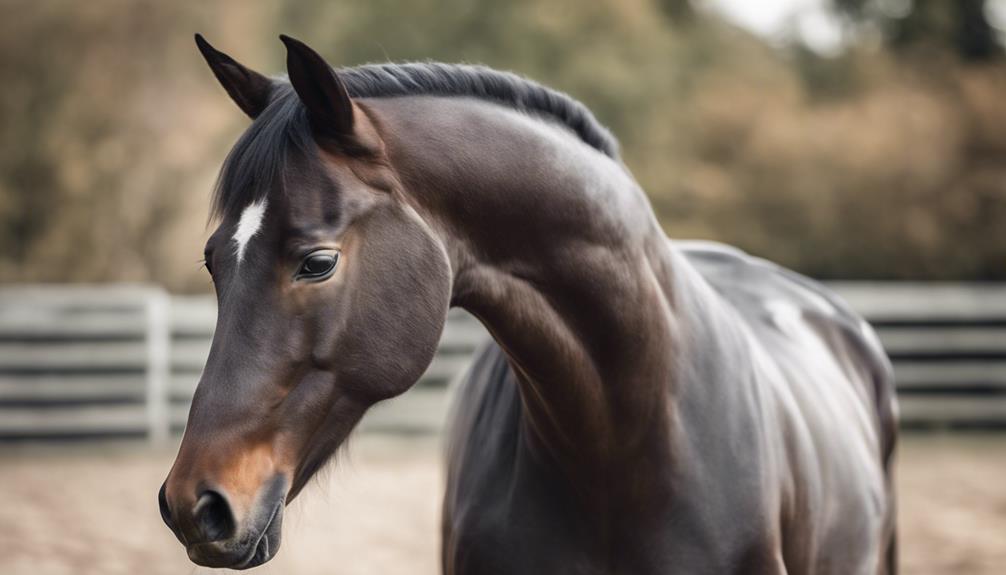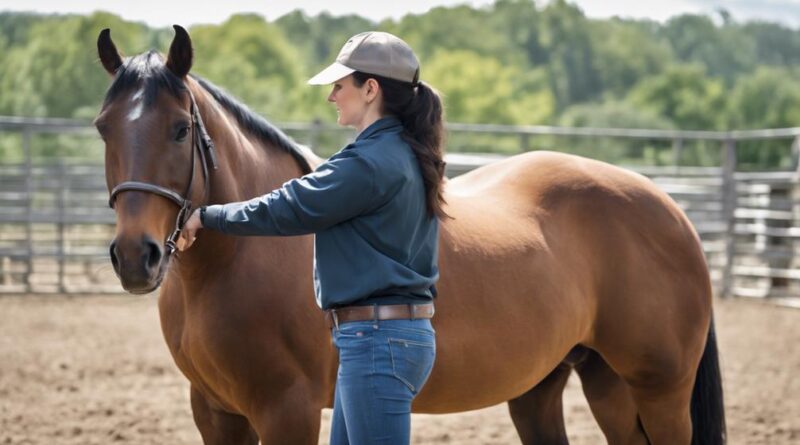Horse Behavior-Based Training: A Comprehensive Guide
As you lead your horse from the paddock, you notice a subtle shift in its body language—a flicker of the ears, a slight tensing of the muscles. Understanding these cues is crucial in effective horse behavior-based training.
By deciphering the intricate ways horses communicate, you can establish a deeper connection and achieve remarkable results. Mastering the art of interpreting equine behavior opens doors to a world of possibilities in training that goes beyond mere commands and techniques.
It unveils a path to truly understanding and communicating with these majestic animals, creating a partnership built on trust and mutual respect.
Understanding Equine Body Language
Understanding equine body language is crucial for effective communication and building a strong bond with your horse. Horses primarily rely on nonverbal communication to convey their feelings, needs, and intentions. By paying close attention to their body signals, you can better understand what your horse is trying to communicate.
One key aspect of equine body language is through their ears. A horse with ears forward is usually alert and interested, while ears pinned back indicate aggression or discomfort. Additionally, the position of their head and neck can also provide valuable insights. A lowered head and relaxed neck often signal relaxation and contentment, whereas a raised head and tense neck may indicate fear or agitation.
Furthermore, observing your horse's overall posture is essential in deciphering their messages. A horse standing with a relaxed stance, weight evenly distributed, and a soft expression is likely feeling calm and comfortable. On the other hand, a tense posture, shifting weight, or a raised tail could signify unease or potential aggression.
Establishing Trust and Respect
How can you effectively establish trust and respect with your horse?
Trust exercises and respecting boundaries are key components in building a strong relationship with your equine companion. Trust exercises involve activities such as ground work, where you lead your horse through obstacles or ask them to follow you without a lead rope. These exercises help your horse learn to trust your guidance and leadership. By consistently engaging in trust exercises, you show your horse that you're a reliable and trustworthy partner.
Respecting boundaries is equally important in earning your horse's trust and respect. Horses have personal space boundaries, and it's crucial to be aware of and respect these boundaries. Invading a horse's space without permission can lead to fear or aggression. Always approach your horse calmly and give them the opportunity to interact with you on their terms. Building trust and respect takes time and patience, so be consistent in your efforts.
When establishing trust and respect with your horse, remember that every interaction counts. Be mindful of your body language, tone of voice, and overall demeanor. By creating a safe and consistent environment, your horse will feel secure and develop a deep bond with you. Trust exercises and respecting boundaries are foundational in nurturing a harmonious and respectful relationship with your horse.
Reading Horse Facial Expressions
When observing your horse, pay close attention to their facial expressions as they can provide valuable insights into their emotions and state of mind. Understanding emotions and nonverbal communication is crucial in building a strong connection with your horse. Here are some key facial expressions to look out for:
- Eyes: The eyes are a window to your horse's soul. Wide eyes may indicate fear or excitement, while half-lidded eyes can signal relaxation or contentment.
- Nostrils: Flared nostrils often suggest heightened emotions such as stress, excitement, or anger. On the other hand, relaxed nostrils indicate a calm and content state.
- Mouth: A tense mouth with tight lips could indicate discomfort or anxiety. Conversely, a soft, slightly open mouth signifies relaxation and trust.
- Ears: Your horse's ears are like antennas. Forward-pointing ears show interest or alertness, while pinned back ears may indicate aggression or fear.
Building a Strong Bond
Strengthen your connection with your horse by engaging in activities that promote trust and mutual understanding. Bonding activities are crucial for relationship building and connection strengthening. Spending quality time together, such as grooming your horse or taking leisurely walks, can foster a sense of companionship.
Trust exercises are also essential in building a strong bond with your horse. These activities can include ground exercises where your horse learns to trust your guidance and leadership. Working on ground manners and basic commands can help establish a foundation of respect and trust between you and your horse.
In addition to physical activities, communication plays a vital role in strengthening your bond. Pay attention to your horse's body language and respond accordingly. Understanding your horse's signals and cues will help you build a deeper connection based on mutual respect and trust.
Interpreting Tail and Ear Movements
Interpreting your horse's tail and ear movements can provide valuable insight into their emotions and intentions. Understanding their tail language and ear signals can help you communicate better with your horse and strengthen your bond. Here's a guide to interpreting these key cues:
- Tail Language:
- Swishing Tail: Indicates irritation or agitation. Your horse may be feeling uncomfortable or annoyed.
- Elevated Tail: A raised tail can signal alertness or excitement. It may indicate that your horse is engaged and attentive.
- Clamped Tail: A tightly held or pinned tail suggests fear or anxiety. Your horse may be feeling threatened or stressed.
- Wagging Tail: Similar to a dog, a horse wagging its tail can indicate a friendly or playful mood. It could be a sign of happiness and relaxation.
- Ear Signals:
- Forward Ears: Pointed forward ears generally indicate attentiveness and curiosity. Your horse is likely focused on something in front of them.
- Pinned Back Ears: Ears flattened back against the head can signal aggression, submission, or pain. It's essential to assess the situation carefully.
- Relaxed Ears: Soft, drooping ears usually indicate relaxation and contentment. Your horse is likely feeling comfortable and at ease.
- Flicking Ears: Rapid flicking or twitching of the ears can suggest indecision or nervousness. Your horse may be unsure or on edge.
Implementing Positive Reinforcement Techniques
To effectively train your horse using positive reinforcement techniques, focus on rewarding desired behaviors consistently. Clicker training is a popular method that involves using a clicker to create a distinct sound as a marker signal to pinpoint the exact moment your horse performs the desired behavior. This signal helps your horse understand which specific action is being rewarded. When starting clicker training, associate the click sound with treats to reinforce positive behavior effectively.
Treats play a crucial role in positive reinforcement training. Choose treats that your horse finds highly rewarding and use them sparingly to maintain their value as a reinforcer. Treats should be small, easy to eat, and something your horse enjoys. Remember to adjust the quantity of treats based on your horse's individual preferences and dietary requirements.
Marker signals, like the clicker, are essential for shaping behavior through positive reinforcement. By consistently using marker signals and rewarding desired behaviors, you can gradually shape more complex actions. Break down the desired behavior into small achievable steps, rewarding each step until the horse can perform the entire behavior successfully.
Incorporating positive reinforcement techniques, such as clicker training and using treats as rewards, along with marker signals, will help you effectively shape your horse's behavior. Consistency, patience, and clear communication through markers are key to successful positive reinforcement training.
Recognizing Signs of Stress

Recognize common signs of stress in your horse by observing their body language and behavior closely during training sessions. It's crucial to understand these signals to ensure your horse's well-being and to maintain a positive training experience. Here are some key indicators to look out for:
- Body Tension: Notice if your horse seems tense or rigid, as this could indicate stress. Watch for stiffness in their movements and overall posture.
- Increased Agitation: Keep an eye out for behaviors such as pawing, tail swishing, or pinned ears, which may suggest your horse is feeling anxious or stressed.
- Excessive Sweating: If your horse is sweating more than usual, especially in non-physical or cooler conditions, it could be a sign of stress.
- Avoidance or Resistance: Pay attention if your horse starts avoiding certain tasks or becomes resistant to cues they previously understood. This could signal underlying stress or discomfort.
Crafting Tailored Training Plans
When tailoring training plans for your horse, consider their individual needs and behaviors to optimize the learning process. Understanding your horse's behavior is crucial in crafting effective training strategies. Behavior modification techniques can be applied to address specific issues and enhance learning outcomes.
Start by observing your horse closely to identify their behaviors, preferences, and triggers. This information will help you design a training plan that suits their unique personality. For instance, if your horse gets easily spooked, gradually expose them to the triggering stimuli in a controlled environment to desensitize them.
Incorporate positive reinforcement techniques such as treats, praise, or scratches to reward desirable behaviors. This encourages your horse to repeat these actions, speeding up the learning process. Conversely, avoid punishment-based methods that can lead to fear or aggression.
Break down training tasks into manageable steps to prevent overwhelming your horse. Progress gradually, building on small achievements to keep your horse motivated and engaged. Consistency is key in reinforcing new behaviors, so make sure to stick to your training plan.
Frequently Asked Questions
How Can I Tell if My Horse Is in Pain or Discomfort While Training?
If your horse is in pain or discomfort during training, it's crucial to recognize signs like changes in behavior, resistance, or tension. Pain indicators may include lameness, stiffness, or sensitivity to touch.
To address this, consider training modifications such as reducing intensity or seeking veterinary advice. Manage aggression by understanding its root cause and implementing positive reinforcement techniques.
Prioritize your horse's well-being by being attentive to their physical and emotional cues.
Are There Specific Breeds of Horses That Are More Responsive to Behavior-Based Training Techniques?
Different breeds of horses vary in their training response due to their unique characteristics and behaviors. Understanding equine behavior can help you tailor your training methods to suit the individual needs of your horse.
While some breeds may be more responsive to behavior-based training techniques, the key to training effectiveness lies in consistency, patience, and building a strong bond with your horse regardless of its breed.
How Do I Handle a Situation Where My Horse Becomes Aggressive During Training?
When your horse becomes aggressive during training, it's crucial to stay calm and focused. Use de-escalation techniques like maintaining a safe distance, avoiding sudden movements, and speaking softly.
Prioritize safety measures by wearing protective gear and ensuring a secure environment. Remember to address the root cause of the aggression and seek guidance from a professional if needed.
Building trust and establishing boundaries will help prevent future incidents.
What Are Some Common Mistakes That Beginner Trainers Make When Using Positive Reinforcement Techniques?
When using positive reinforcement techniques, beginner trainers often make common pitfalls. These include inconsistent rewards, not timing rewards properly, and lack of clarity in communication.
To avoid these mistakes, you should focus on consistency, timing rewards immediately after the desired behavior, and using clear cues.
Is It Possible to Train Older Horses Using These Behavior-Based Methods, or Are They More Effective on Younger Horses?
Yes, you can definitely train older horses using behavior-based methods. Senior horse training can be effective and rewarding. Training older horses requires patience, consistency, and understanding.
Conclusion
By understanding and interpreting your horse's behavior, you can create a strong bond built on trust and respect. Utilizing positive reinforcement techniques and tailoring training plans to your horse's needs will lead to a successful and fulfilling partnership.
Remember to always pay attention to your horse's body language, facial expressions, and movements to ensure a positive and stress-free training experience. With patience and dedication, you can achieve great results in training your horse using behavior-based methods.
